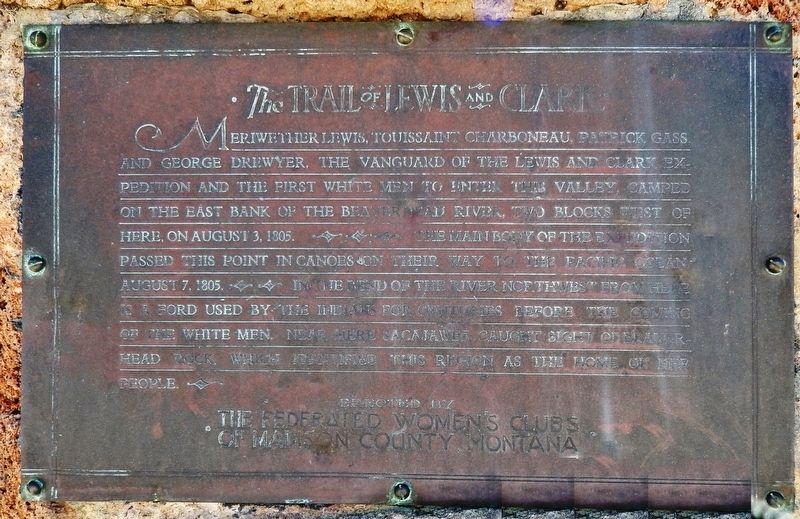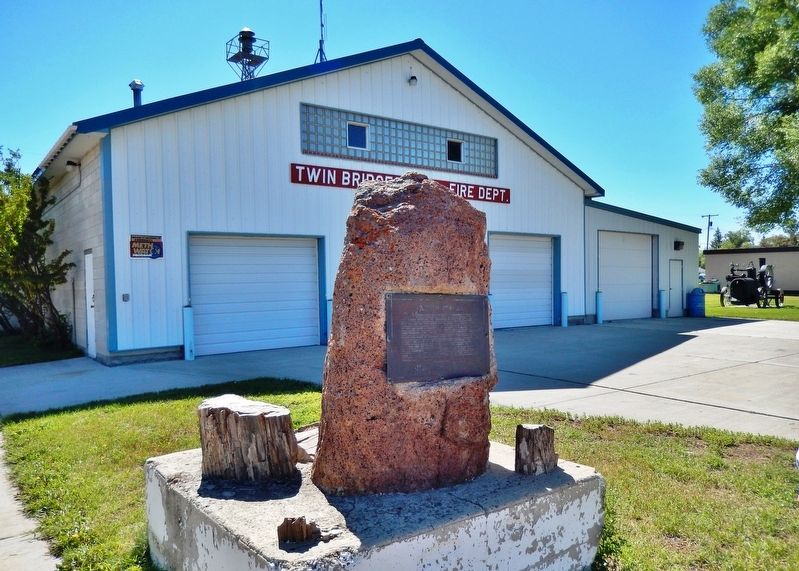Twin Bridges in Madison County, Montana — The American West (Mountains)
The Trail of Lewis & Clark
The main body of the expedition passed this point in canoes on their way to the Pacific Ocean August 7, 1805.
In the bend of the river northwest from here is a ford used by the Indians for centuries before the coming of the white men. Near here Sacajawea caught sight of Beaverhead Rock, which identified this region as the home of her people.
The Federated Women’s Clubs of Madison County Montana
Erected by The Federated Women's Clubs of Madison County Montana.
Topics and series. This historical marker is listed in these topic lists: Exploration • Native Americans. In addition, it is included in the Lewis & Clark Expedition series list. A significant historical date for this entry is August 3, 1805.
Location. 45° 32.747′ N, 112° 19.847′ W. Marker is in Twin Bridges, Montana, in Madison County. Marker is at the intersection of North Main Street (State Highway 41) and East 6th Avenue, on the right when traveling north on North Main Street. Marker is located at the southeast corner of the intersection, directly in front of the Twin Bridges Fire Department. Touch for map. Marker is at or near this postal address: 104 East 6th Avenue, Twin Bridges MT 59754, United States of America. Touch for directions.
Other nearby markers. At least 8 other markers are within walking distance of this marker. Road Agent Trail (approx. 0.2 miles away); Sacajawea, "Pomp" and Seaman (approx. 0.2 miles away); Jefferson River - Beaverhead River (approx. 0.2 miles away); Which way did they go? (approx. 0.2 miles away); Recognizing her people's land (approx. 0.2 miles away); "...a handsome little river..." (approx. 0.2 miles away); Pavilion (approx. 0.2 miles away); Madison County Fairgrounds (approx. ¼ mile away). Touch for a list and map of all markers in Twin Bridges.
More about this marker. Marker is a large metal plaque, mounted vertically at waist-level on a 5-foot tall stone monument.
Also see . . . Beaverhead Rock - Sacagawea's landmark. "The Indian woman," wrote Meriwether Lewis, "recognized the point of a high plain to our right which she informed us was not very distant from the summer retreat of her nation on a river beyond the mountains which runs to the west. This hill she says her nation calls the beaver's head from a conceived resemblance of its figure to the head of that animal." (Submitted on January 8, 2019, by Cosmos Mariner of Cape Canaveral, Florida.)
Credits. This page was last revised on January 11, 2019. It was originally submitted on January 8, 2019, by Cosmos Mariner of Cape Canaveral, Florida. This page has been viewed 211 times since then and 13 times this year. Photos: 1, 2. submitted on January 8, 2019, by Cosmos Mariner of Cape Canaveral, Florida. • Bill Pfingsten was the editor who published this page.

